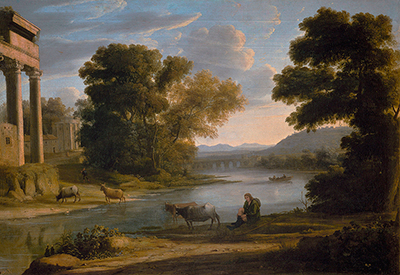Claude Lorrain produced a number of landscape paintings which carried similar titles, such as The Ford or River Ford. The example in front of us here is dated circa 1644 and can now be found in the permanent collection of the Prado Museum in Spain.
This variant sees a young man crouching by a ford. He is joined by a number of animals who happily relax on either side of the water. The river snakes round a wide bend, before reaching a long bridge in the very far distance. A small boat makes it way across the artwork, in an addition which the artist used in several pieces. Trees overhang on both sides of the shore, bringing darker shadowed areas to counter the bright sky above. A number of hills peak out from the very far distance but most of the upper half of the work is devoted to the bright, clear sky. To the left hand side we then find some buildings in a classical style that are partially cropped out of that side of the canvas. The ford itself which covers much of the centre of the composition appears entirely calm, providing a relaxing atmosphere within this piece. Again, we find the formula used by Claude throughout much of his career, with certain elements re-arranged to create new artworks that followed a very clear and consistent style.
The Prado Museum has a small selection of work from his career, with many of his highlights to be found elsewhere in France, Italy and the UK. Perhaps his most famous paintings of all would be Landscape with Ascanius Shooting the Stag of Sylvia, The Embarkation of the Queen of Sheba and also Seaport at Sunset. The artist used sunrises and sunsets much more than had been seen before by that point, and this topic would be taken on by other artists as a result of his success. Before the time of Lorrain, landscapes would be used as a supporting element within European art but now they would become the single element in some popular artworks. This artist's influence was therefore crucial in opening the way for later generations of painters who wanted to focus on nature within their work. Lorrain was not as varied as some might like but he found a formula that worked and stuck with it for many decades, building up an impressive list of patrons as he did so.
The artist was born in what is now France, but moved to Italy after the death of his parents. He eventually became an artist and worked in a number of workshops in order to learn his craft. Some of these were run by Italian landscape painters and this must have influenced him to follow much the same path into this genre himself. He worked mainly from Rome, but his list of patrons would be from across Europe as word of his talents started to spread. He is today well represented in many major European cities, such as London, Paris and Rome, with many 19th century collectors working hard to acquire his work during a period in which he was particularly fashionable. His legacy remains well understood and respected today right across the continent.




